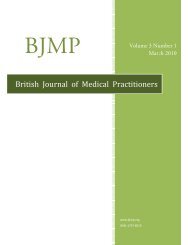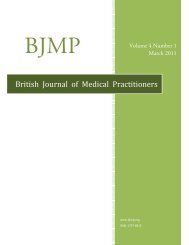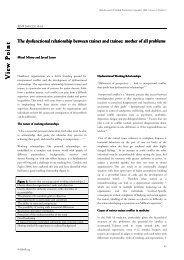R esearch A rticle - British Journal of Medical Practitioners
R esearch A rticle - British Journal of Medical Practitioners
R esearch A rticle - British Journal of Medical Practitioners
Create successful ePaper yourself
Turn your PDF publications into a flip-book with our unique Google optimized e-Paper software.
<strong>British</strong> <strong>Journal</strong> <strong>of</strong> <strong>Medical</strong> <strong>Practitioners</strong>, March 2013, Volume 6, Number 1<br />
Table 2. Overlooked neuropsychiatric syndromes found in Parkinson’s<br />
Disease.<br />
Neuropsychiatric syndrome<br />
Prevalence<br />
Anxiety disorders Up to 40%<br />
Apathy 16-42%<br />
Involuntary emotional expression disorder Up to 16.8%<br />
Sleep disorders 60-98%<br />
Impulse control disorders Up to 13.6%<br />
Anxiety Disorders<br />
Epidemiology<br />
There is a wide range in the reporting <strong>of</strong> the prevalence <strong>of</strong><br />
anxiety in patients with PD. Anxiety is significantly more<br />
prevalent in PD sufferers compared with age and sex matched<br />
non-sufferers. Prevalence is quite high with estimates indicating<br />
that up to 40% <strong>of</strong> PD patients suffer significant<br />
anxiety. 10 However, clinicians’ recognition and awareness <strong>of</strong><br />
anxiety in PD need to be raised because it is likely to be underdiagnosed<br />
and untreated. 11, 12 Consequently the prevalence <strong>of</strong><br />
anxiety may be even higher. Severity <strong>of</strong> anxiety is not correlated<br />
with severity <strong>of</strong> parkinsonian symptoms, duration <strong>of</strong> levodopa<br />
use, or current dose <strong>of</strong> levodopa.<br />
Aetiology and risk factors<br />
Anxiety is an understandable psychological response to the<br />
physical symptoms, to the neurochemical changes <strong>of</strong> the disease<br />
itself, or as a side effect <strong>of</strong> the various medications used to treat<br />
the condition. 10 Sleep disturbances and cognitive impairment<br />
have been proposed as possible aetiological factors for anxiety in<br />
PD. 11, 12 Depression in PD may manifest in two clinical<br />
phenotypes, one ‘anxious-depressed’ and the other ‘depressed’.<br />
However, a further large proportion <strong>of</strong> patients can have<br />
relatively isolated anxiety. 13<br />
Anxiety frequently precedes the development <strong>of</strong> motor<br />
symptoms, suggesting specific neurobiological processes are<br />
involved, not merely social and psychological reactions in<br />
learning to adapt to PD. 14<br />
Patients with postural instability and gait dysfunction have a<br />
higher incidence <strong>of</strong> anxiety compared with tremor-dominant<br />
patients. Younger-onset PD patients are also more likely to<br />
experience anxiety. The pathogenesis <strong>of</strong> anxiety involves<br />
noradrenergic, serotonin and dopamine neurotransmitters.<br />
GABAergic pathways may also be involved. 14 Right hemisphere<br />
disturbances have also been implicated, particularly with panic<br />
disorder. Symptom variation in PD may be due to medication,<br />
as well as motor fluctuations. 11 One study revealed that<br />
although the dose <strong>of</strong> levodopa was not associated with anxiety,<br />
the experience <strong>of</strong> dyskinesia or on-<strong>of</strong>f fluctuations increased the<br />
12, 14, 15<br />
risk <strong>of</strong> anxiety.<br />
Presentation and diagnosis<br />
The commonest disorders found in PD are generalised anxiety,<br />
panic disorder, and social phobia. Anxiety contributes to the<br />
complexity <strong>of</strong> PD and lowers quality <strong>of</strong> life. 14, 15 The degree <strong>of</strong><br />
comorbidity between anxiety and depression in PD patients is<br />
in excess <strong>of</strong> that found in patients without PD. While anxiety is<br />
significantly associated with depression, some patients show<br />
anxiety without depression. 10<br />
The main features <strong>of</strong> anxiety are inappropriate feelings <strong>of</strong><br />
apprehension as well as mood, cognitive, and somatic changes.<br />
Some symptoms may be common to PD, such as autonomic<br />
symptoms, fatigue, muscle tension, insomnia and attention<br />
problems. Psychologically, anxiety in PD is understandable<br />
because being diagnosed with a chronic disease with no known<br />
cure and an inexorable course, would be difficult for anyone to<br />
contemplate. Motor signs and changes in appearance could<br />
explain social anxiety. However, the frequency <strong>of</strong> anxiety in PD<br />
seems to be higher than in other chronic diseases and unrelated<br />
to the severity <strong>of</strong> motor signs. Even in social phobia the phobic<br />
symptoms do not correlate with disease severity and are not<br />
restricted to performance situations. Furthermore, anxiety can<br />
precede motor signs by several years, suggesting that the<br />
neurobiological substrate <strong>of</strong> PD is responsible for anxiety at<br />
least in part.<br />
Treatment<br />
Treatment comprises the use <strong>of</strong> selective serotonin reuptake<br />
inhibitors (SSRIs) such as sertraline, fluoxetine and citalopram<br />
as well as other newer antidepressants - serotonin and<br />
noradrenaline reuptake inhibitor (SNRIs) for example,<br />
venlafaxine, cognitive behavioural therapy (CBT), exercise, the<br />
occasional use <strong>of</strong> atypical neuroleptics, and<br />
benzodiazepines. 14 However, benzodiazepines have a tendency<br />
to cause sedation, unsteadiness <strong>of</strong> gait, and even confusion.<br />
Antidepressants are useful because they treat both anxiety and<br />
depression that <strong>of</strong>ten overlap: depression coexists with anxiety<br />
in 14% <strong>of</strong> cases. 15 Low dose tricyclic antidepressants with<br />
minimal anticholinergic effects may be useful in those patients<br />
who do not respond to benzodiazepines.<br />
Apathy<br />
Epidemiology<br />
Apathy, a state <strong>of</strong> lethargic indifference and loss <strong>of</strong> motivation,<br />
and fatigue are prominent non-motor symptom in PD with a<br />
prevalence <strong>of</strong> between 16-42%. 16, 17 Fatigue is a sense <strong>of</strong><br />
tiredness or exhaustion, due to mental or physical causes.<br />
Apathy and fatigue are important because they have significant<br />
repercussions for the quality <strong>of</strong> life in PD. 18, 19 Apathy can exist<br />
without depression but, by definition, patients themselves do<br />
not complain <strong>of</strong> apathy, though are found to be unmotivated to<br />
engage in activities. Apathy and fatigue are <strong>of</strong>ten difficult to<br />
BJMP.org<br />
24







